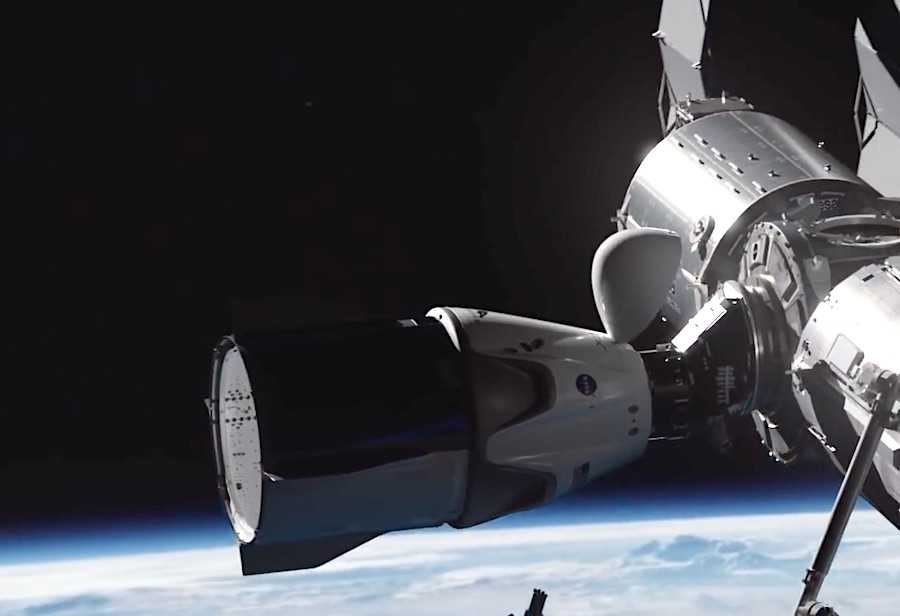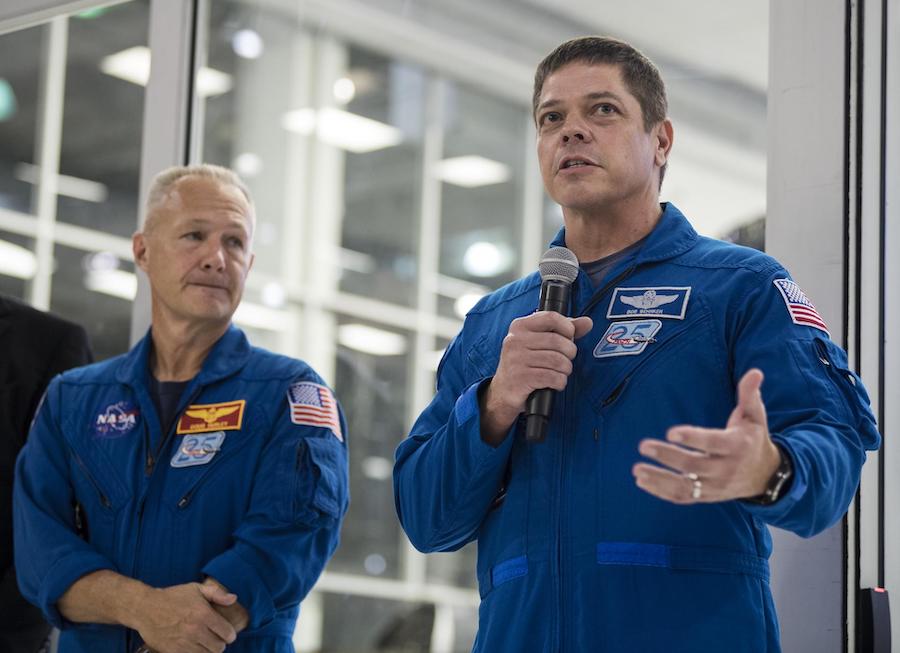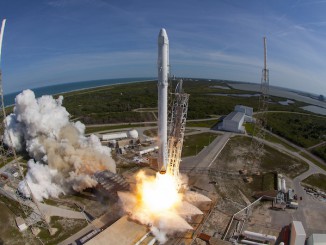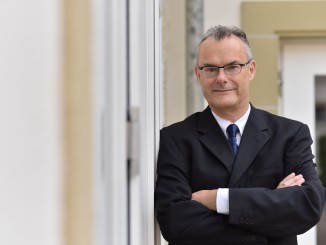
NASA astronauts Bob Behnken and Doug Hurley will be geared up for the long haul when they launch from the Kennedy Space Center on a SpaceX Crew Dragon spacecraft later this month, but they won’t know exactly how long they will be in orbit until they are already aboard the International Space Station.
The Dragon astronauts, both veterans of two space shuttle missions, could live and work on the space station for one to four months, according to NASA officials. The duration will primarily hinge on how well the Crew Dragon’s solar panels hold up in the harsh environment of space.
“The minimum mission duration is really about a month, and the maximum is 119 days,” said Steve Stich, deputy manager of NASA’s commercial crew program.
The Crew Dragon test flight — set for liftoff at 4:33 p.m. EDT (2033 GMT) May 27 — will be the first launch of astronauts into orbit from the Kennedy Space Center since July 8, 2011, when the shuttle Atlantis rocketed into space on the final flight of the space shuttle program.
If the mission launches May 27, the Crew Dragon is scheduled to autonomously dock with the International Space Station at 11:39 a.m. EDT (1539 GMT) May 28. Behnken and Hurley originally planned to fly to the space station for no more than a couple of weeks after launching on a SpaceX Falcon 9 rocket.
The purpose of the Crew Dragon demonstration flight, named Demo-2 or DM-2, is primarily intended to test the commercial crew ship’s performance with astronauts on-board. It follows a six-day unpiloted Crew Dragon test flight to the space station in March 2019.
But NASA has approved an extension to the Demo-2 mission. Faced with the prospect of a period of months with just one U.S. astronaut aboard the space station — limiting opportunities for maintenance and repair spacewalks, and restricting the station’s scientific output — NASA is planning to keep Behnken and Hurley at the $100 billion orbiting research outpost for up to four months.
NASA astronaut Chris Cassidy launched from Kazakhstan on a Soyuz rocket April 9 with two Russian crewmates.
“This launch will allow researchers around the globe to work with astronauts on-board the space station to undertake many different scientific investigations,” said Kirk Shireman, NASA’s space station program manager at the Johnson Space Center in Houston. “The SpaceX crew, with Chris Cassidy already on-board the International Space Station, will be doing experiments on physiology, cardiovascular experiments, physical and life sciences, testing out life support systems … and testing out habitation experiments for our future human space exploration.”
Behnken could also join Cassidy in a series of spacewalks to replace batteries on one of the space station’s solar power trusses. The new lithium-ion batteries will be delivered to the space station later this month on an automated Japanese HTV supply ship.
NASA originally intended to have SpaceX’s Crew Dragon and Boeing’s Starliner crew capsules certified by now for operational crew rotation flights to and from the space station. But development delays in both programs — originally due to NASA funding shortfalls, then caused by a series of technical problems — have pushed back the start of regular commercial taxi service to the space station by years.
NASA has signed agreements with SpaceX worth more than $3.1 billion since 2011 to pay for development of the Crew Dragon spacecraft. SpaceX has also pitched in an undisclosed sum of its own money to help fund the program.
Boeing and NASA have a similar series of contracts valued at nearly $5 billion in a public-private partnership to develop the Starliner spacecraft. The Starliner failed to dock with the space station on an automated test flight in December, and Boeing plans to repeat the orbital demonstration mission later this year before NASA clears the Starliner to fly astronauts.
The Russian Soyuz capsule has been the only spacecraft capable of carrying crews to the space station since the space shuttle program ended. NASA has paid the Russian government approximately $3.9 billion since 2006 to purchase Soyuz seats for astronauts from the United States and the station’s other international partners, according to a report last year by NASA’s inspector general.
NASA expects to end payments to Russia once the new U.S. crew ships are operational. Under the space agencies’ current plans, U.S. astronauts will continue flying on Soyuz spacecraft and Russian cosmonauts will launch and land on the new U.S. vehicles under a barter arrangement, with no funds exchanged.
But Russian officials say they are not assigning cosmonauts to missions on U.S. vehicles until they are flight-proven.
Flush with NASA money, Russian space contractors doubled the production of Soyuz crew capsules for launches beginning in 2009 to meet the demand for astronaut transportation to the space station. After NASA’s last Soyuz seat purchase in 2017, the schedule for Soyuz crew missions has been cut back to two flights this year.
Cassidy took the last Soyuz seat under NASA’s control, but the agency is negotiating to purchase one more round-trip Soyuz ticket for a launch in October.
NASA and SpaceX hope the first operational Crew Dragon mission, designated Crew-1, could be ready to launch some time this fall. But NASA wants a backup plan to ensure a U.S. astronaut can get to the space station in case of additional delays.
Regular crew rotation flights using the Crew Dragon capsule could last up to 210 days, but NASA and SpaceX are setting tighter limits for Behnken and Hurley’s mission due to the experimental nature of the Demo-2 test flight.

Stich said preflight analyses show the Crew Dragon spacecraft set to fly the Demo-2 mission can safely remain in orbit for up to 119 days, or about four months, based on a “worst-case” prediction for how the ship’s solar arrays will perform in orbit.
“Any solar array in low Earth orbit tends to degrade a little bit over time,” said Stich, a former space shuttle flight director. “It turns out the atmosphere has a little bit of oxygen in it — it’s called atomic oxygen — so there’s a little bit of degradation in the ability of that solar array, the cell itself, to generate power.”
Once the Crew Dragon is docked to the space station, SpaceX and NASA engineers will assess data the solar arrays’ performance and efficiency to determine when to bring the crew back to Earth.
“What we’ll do is we have this curve of what we expect that degradation to be over time,” Stich said. “We can kind of look at the power the arrays generate each day, and kind of plot that against this prediction, and that can give us the overall total capability.”
The solar arrays on SpaceX’s new-generation Dragon spacecraft, called Dragon 2 or Crew Dragon, are mounted on the body of the spaceship’s unpressurized trunk. The trunk is attached to the aft end of the Dragon’s pressurized crew cabin, and a thermal radiator sits on the opposite side of the cylindrical trunk from the solar arrays.
SpaceX’s previous Dragon design, which retired earlier this year after 20 unpiloted cargo delivery flights to the space station, used unfolding solar panels to generate electricity.
“We looked at the rest of the vehicle, (and) we don’t see any other life limiters,” Stich said in a May 1 press conference. “We looked at the pumps on the thermal system, we looked at the propulsion system, all the other components, when we talked about extending the mission, and the solar arrays are the only one really that have a little bit of a poke-out.
“So we’ll just kind of watch their performance in flight and be able to make a good decision about how long to stay docked,” he said.
NASA is balancing the objectives of the Demo-2 test flight with satisfying the agency’s desire for extra manpower on the space station.
“We’re really trying to do both a test flight with this vehicle, and also have the vehicle docked to station to allow Bob and Doug to augment the station crew,” Stich said.
When astronauts launch on SpaceX’s Dragon capsule from the Kennedy Space Center on May 27, it will be the first time a new vehicle design has carried people into orbit from the United States in more than 39 years, says NASA Administrator Jim Bridenstine. https://t.co/wkefgClNz9 pic.twitter.com/V5gQpSUeGP
— Spaceflight Now (@SpaceflightNow) May 13, 2020
Hurley, the Demo-2 spacecraft commander, said the unknown mission duration is one of the challenges of preparing for the trip to the space station.
“I think that’s more of a human element,” Hurley said. “We go in it knowing that it could be 30 days up to four months, and it’ll probably end up being somewhere in between that. But that’s certainly an unknown, from a personal standpoint, that you’d like to maybe have a little bit better answer for, but we certainly understand the reasons why, and I think hopefully we’ll be able to offer some good support to Chris Cassidy, who’s up there in the U.S. segment on his own right now.”
Officials will also look at the schedule for the following Crew Dragon flight, which will carry four astronauts to the station, when deciding on a schedule for Behnken and Hurley’s return to Earth. And mission managers will assess weather and sea conditions in the Dragon’s splashdown zone roughly 27 miles (24 nautical miles; 44 kilometers) off Florida’s East Coast.
The Dragon demonstration flight will mark the first time astronauts have climbed into a newly-designed spaceship and launched into orbit since 1981, when the first space shuttle took off from pad 39A, the same historic launch complex where Behnken and Hurley will launch later this month.
“We think about Mercury, Gemini, Apollo and then space shuttle,” Bridenstine said. “Those are really the four times in history when we have put humans on brand new spacecraft, and now we’re doing it for a fifth time, and that’s just the United States.
“If you look globally, this will be the ninth time in history when we’ve put humans on a brand new spacecraft (design),” he said. “And the last time the United States did it was on STS-1, when we launched the the space shuttle for the first time back in 1981. So it’s been a long time since we put humans on a brand new spacecraft. Thats what this is and it is truly a test flight.”
Email the author.
Follow Stephen Clark on Twitter: @StephenClark1.



